
Mazda Motor Corporation, also known as simply Mazda, is a Japanese multinational automotive manufacturer headquartered in Fuchū, Hiroshima, Japan. The company was founded on January 30, 1920, as Toyo Cork Kogyo Co., Ltd., a cork-making factory, by Jujiro Matsuda. It changed its name to Toyo Kogyo Co., Ltd. in 1927 and started producing vehicles in 1931. The name Mazda was derived from Ahura Mazda, the god of harmony, intelligence and wisdom in Zoroastrianism, as well as from the surname of the founder. Mazda is one of the largest automakers in Japan and the world. In 2015, it produced 1.5 million vehicles for global sales, of which nearly one million were made in Japan and the rest in various other countries. It ranked as the 15th-largest automaker by production volume globally in 2015. Mazda is known for its innovative technologies, such as the Wankel engine, the SkyActiv platform, and the Kodo Design language. It also has a long history of motorsport involvement, winning the 24 Hours of Le Mans in 1991 with the rotary-powered Mazda 787B. Mazda has several alliances and partnerships with other automakers, such as Toyota, Nissan, Isuzu, Suzuki and Ford.

The Ford Laser is a compact car, originally a subcompact car in the first three generations, which was sold by Ford in Asia, Oceania, and parts of South America and Africa. It has generally been available as a sedan or hatchback, although convertible, wagon and pick-up versions have also been available in different markets. The sedan, and briefly station wagon, versions were badged Ford Meteor in Australia between 1981 and 1987. The Ford Meteor name was also used in South Africa.

The Ford Festiva is a subcompact car that was designed and manufactured by Mazda for Ford between 1986 and 2002. Festiva was sold in Japan, the Americas, and Australia. The name "Festiva" is derived from the Spanish word for "festive". It was not related to the similarly sized and named Ford Fiesta, and was not replaced by the Ford Ka, which is smaller.

The Ford Fiesta is a supermini car that was marketed by Ford from 1976 to 2023 over seven generations. Over the years, the Fiesta has mainly been developed and manufactured by Ford's European operations, and had been positioned below the Escort.

The Ford Probe is a liftback coupé produced by Ford, introduced in 1988 and produced until 1997. The Probe was the result of Ford's collaboration with its longtime Japanese partner Mazda, and both generations of Probe were derived from the front-wheel drive Mazda G platform that underpinned the Mazda Capella.

The Mazda Luce is an executive car that was produced by Mazda in Japan from 1966 until 1991. It was widely exported as the Mazda 929 from 1973 to 1991 as Mazda's largest sedan. Later generations were installed with luxury items and interiors as the Luce became the flagship offering. The Luce was replaced by the Sentia in 1991 which was also exported under the 929 nameplate.

The Mercury Tracer is an automobile manufactured and marketed by Ford's Mercury division for model years 1987-1999, over three generations in three- and five-door hatchback, four-door sedan, and five-door station wagon configurations.
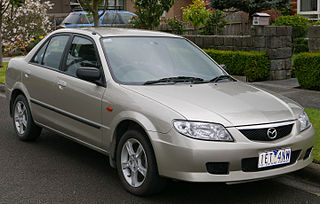
The Mazda Familia, also marketed prominently as the Mazda 323, Mazda Protegé and Mazda Allegro, is a small family car that was manufactured by Mazda between 1963 and 2003. The Familia line was replaced by the Mazda3/Axela for 2004.

The Mazda Demio is a subcompact/supermini/B-segment small car manufactured by Mazda since 1996. While sold across four generations in the domestic Japanese market, the Demio nameplate was rarely used outside of Japan, where it was usually called the Mazda2. The Demio nameplate was retired in 2019 as Mazda changed over to "Mazda2" for their home market as well.

Ford Courier is a model nameplate used by Ford since the early 1950s. The Courier moniker has been used on a variety of vehicles all around the world since it was first used in North America for a sedan delivery. The Courier nameplate was also used by Ford for a series of compact pickup trucks and would also see use by Ford of Europe denoting a Fiesta-based panel van. Ford Brazil used the nameplate for a Fiesta-based coupe utility pickup marketed across Latin America.

Subcompact car is a North American classification for cars smaller than a compact car. It is broadly equivalent to the B-segment (Europe), supermini or A0-class (China) classifications.
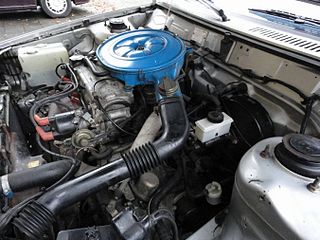
The F engine family from Mazda is a mid-sized inline-four piston engine with iron block, alloy head and belt-driven SOHC and DOHC configurations. Introduced in 1983 as the 1.6-litre F6, this engine was found in the Mazda B-Series truck and Mazda G platform models such as Mazda 626/Capella as well as many other models internationally including Mazda Bongo and Ford Freda clone, Mazda B-series based Ford Courier, Mazda 929 HC and the GD platform-based Ford Probe

Autozam was a brand of Japanese automaker Mazda, specializing in small cars and Kei cars, many of which were rebadged Suzuki models. Autozam also briefly acted as importer of Lancia vehicles to Japan.

The Autozam Revue is a subcompact car that was sold by Autozam, introduced in 1990. The demise of that marque led to the cars being renamed as the Mazda Revue in some markets. The car was also sold in many export markets as the Mazda 121, where it replaced the previous 121 that had been based on the first-generation Ford Festiva.
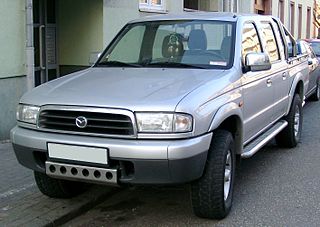
The Mazda B series is a series of pickup trucks that was manufactured by Mazda. Produced across five generations from 1961 to 2006, the model line began life primarily as a commercial vehicle, slotted above a kei truck in size. Through its production, Mazda used engine displacement to determine model designations; a B1500 was fitted with a 1.5 L engine and a B2600, a 2.6 L engine.
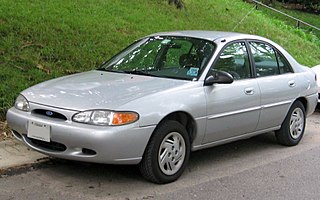
The North American version of the Ford Escort is a range of cars that was sold by Ford from the 1981 to 2003 model years. The direct successor of the Ford Pinto, the Escort also largely overtook the role of the European-imported Ford Fiesta as the smallest vehicle in the Ford model line in North America. Produced across three generations, the first generation was a subcompact; the latter two generations were compact cars. Becoming highly successful in the marketplace, the Escort became the best-selling car in the United States after 1982, a position it would hold for much of the 1980s.
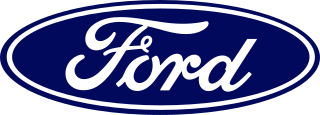
Ford of Europe GmbH is a subsidiary company of Ford Motor Company founded in 1967 in Cork, Ireland, with headquarters in Cologne, Germany.
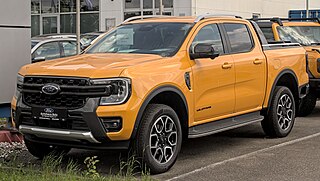
The Ford Ranger is a compact or mid-size pickup marketed globally by Ford over a series of generations, varying between both in-house or outside development and manufacturing — and with a hiatus in North America from 2011-2018.

The Fiesta Mark IV was launched in October 1995 and became Britain's best-selling car from 1996 to 1998, when it was overtaken by the all-new Ford Focus, a replacement for the Ford Escort.























